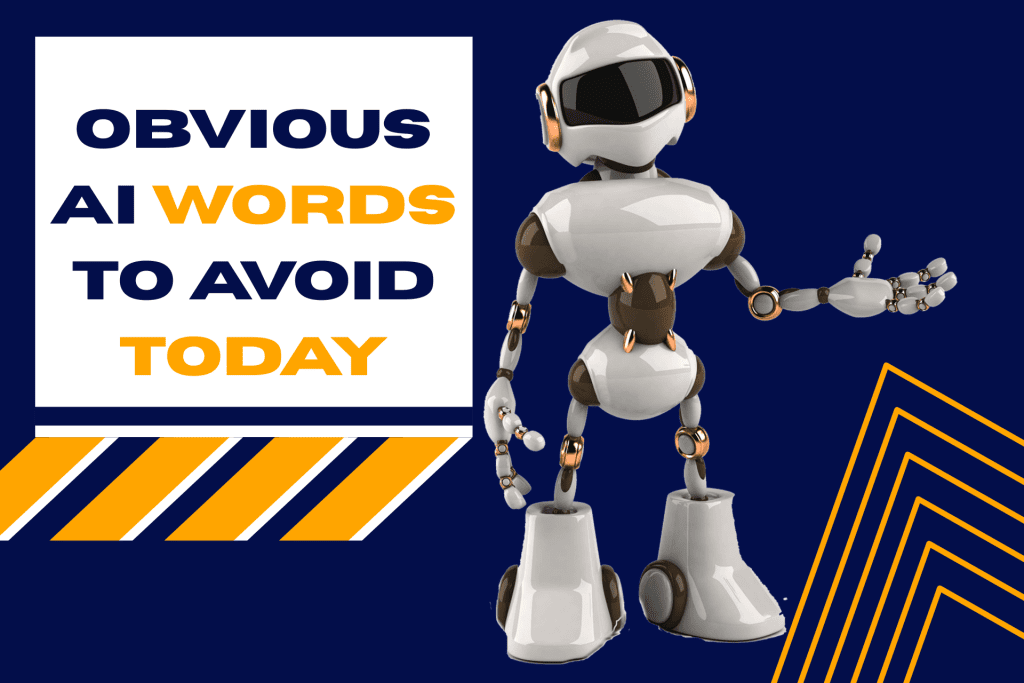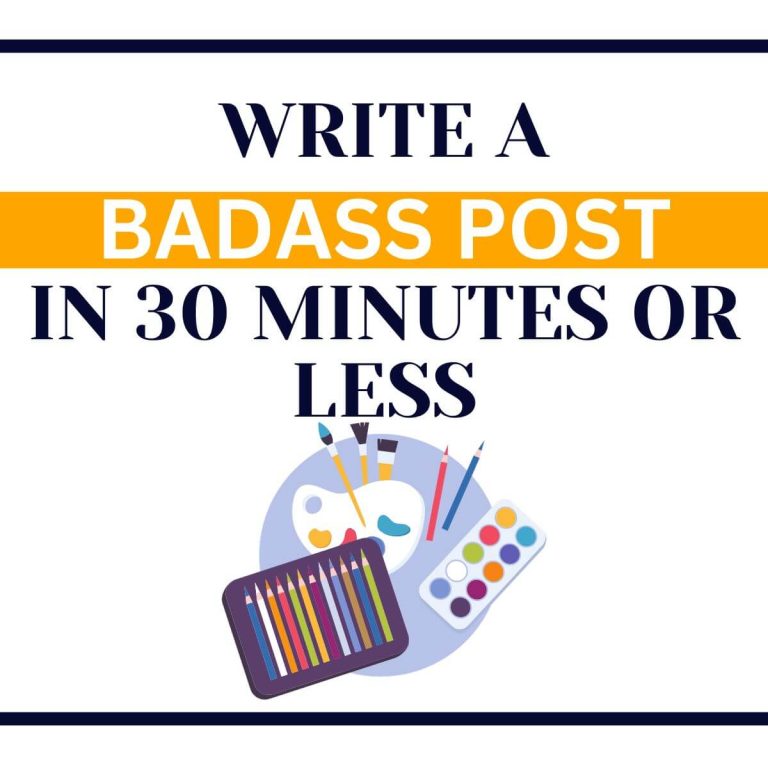Please Follow us on social media >>>>
580+ AI words To Avoid in Your Writing

Obvious AI Words to avoid Today
You read something online and thought, “Hmm, that sounds a little… robotic?”
You’re not alone. Nowadays, there are too numerous Obvious AI Words to avoid.
As artificial intelligence becomes a more common writing assistant, its linguistic quirks and favorite phrases are becoming increasingly noticeable.
While AI is a fantastic tool for brainstorming and drafting, relying too heavily on its raw output leaves writers with content that makes their audience feel distant.
Certain words and phrases have become synonymous with artificial intelligence-generated content, often making writing feel less authentic and engaging.
Let AI be the assistant but always ensure you’re the author.
Echez O’ Ford
The good news?
Once you know what to look for, these AI “words” are surprisingly easy to spot and fix.
Think of it like learning to identify a particular bird by its song; with a little practice, those robotic chirps will stand out clearly.
To help you and your content sound human, I’ve compiled an extensive list of words and phrases that frequently signal AI generation.
This isn’t just a handful of obvious offenders; it’s a deep dive into the vocabulary that AI models tend to overuse.
For each item on this list, I’ll give you a quick pointer on why it sounds like AI and nudge you towards more natural, engaging alternatives.
- Dive: AI’s common verb for exploring; “look into” or “examine” can be more varied.
- Dazzling: Often an over-the-top positive by AI; “impressive” or “striking” are more grounded.
- Enhance: A formal AI favorite for “improve”; consider “boost” or “make better.”
- Discover: AI uses this frequently; “find” or “learn” can be simpler alternatives.
- Unveiling: AI’s somewhat grand way to say “revealing” or “showing.”
- Comprehensive: AI often claims this; “complete” or “detailed” can work, but specifics are better.
- Inquire: An overly formal AI choice for “ask.”
- Discern: Formal AI word for “identify” or “recognize.”
- Vigilance: A rather formal AI term for “alertness” or “watchfulness.”
- Embark: AI’s formal way of saying “begin” or “start,” especially for projects.
- Journey: AI often uses this metaphorically for an “experience” or “process.”
- Elevate: Formal AI choice for “raise,” “lift,” or “improve.”
- Evolution: AI often describes “development” or “progress” this way.
- Shift: AI frequently uses this for “change” or “move.”
- Prevailing: A formal AI term for “common” or “widespread.”
- Unleash: AI often uses this dramatically for “release” or “let loose.”
- Facilitate: Formal AI term for “help,” “aid,” or “make easier.”
- Unveil: (Slightly different from “Unveiling”) AI’s grand way to “reveal” or “show.”
- Elucidate: A very formal AI way to “explain” or “clarify.”
- Leverage: Classic AI business-speak for “use” or “benefit from.”
- Utilize: A formal AI alternative to the simpler word “use.”
- Strategize: AI’s formal word for “plan” or “devise a plan.”
- Innovate: AI often uses this buzzword; “create” or “invent” can be more direct.
- Synthesize: AI uses this for “combine” or “blend” information.
- Expedite: Formal AI word for “speed up” or “accelerate.”
- Cultivate: Formal AI word for “develop” or “foster” (e.g., relationships, skills).
- Delineate: A formal AI term for “outline” or “describe” in detail.
- Articulate: Formal term AI uses for “express” or “state clearly.”
- Navigate: AI’s common metaphor for “guide through” or “deal with” (e.g., complexities).
- Proliferate: Formal AI word for “expand” or “spread rapidly.”
- Augment: AI often uses this for “increase” or “add to.”
- Diversify: AI uses this for “broaden” or “vary.”
- Conceptualize: Formal AI term for “envision” or “imagine.”
- Manifest: AI uses this to mean “show,” “demonstrate,” or “become apparent.”
- Ponder: Formal AI term for “think about” or “consider deeply.”
- Scrutinize: AI’s formal word for “examine” or “inspect closely.”
- Elicit: AI uses this for “bring out” or “draw forth” (e.g., a response).
- Enumerate: AI’s formal way to “list” or “count.”
- Empower: A positive buzzword, but its frequency in AI text is a tell.
- Disseminate: Formal AI word for “spread” or “distribute” (e.g., information).
- Culminate: AI uses this formally to mean “conclude” or “end with.”
- Harness: Frequently used by AI for “control” or “use effectively” (e.g., power, resources).
- Perceive: AI’s formal way of saying “see,” “notice,” or “understand.”
- Actualize: Formal AI term for “realize” or “achieve” (e.g., potential).
- Harmonize: AI uses this for “align,” “coordinate,” or “bring into agreement.”
- Accentuate: Formal AI word for “highlight” or “emphasize.”
- Illuminate: AI’s metaphorical way of saying “clarify,” “explain,” or “light up.”
- Reiterate: AI’s formal term for “repeat” or “restate.”
- Mitigate: Formal AI word for “reduce,” “alleviate,” or “lessen” (e.g., risks).
- Galvanize: AI uses this for “inspire,” “motivate,” or “spur into action.”
- Transcend: Formal AI word for “surpass,” “exceed,” or “go beyond.”
- Advocate: AI uses this formally for “support” or “promote.”
- Exemplify: AI’s formal way to “illustrate” or “be a typical example of.”
- Validate: AI uses this for “confirm,” “verify,” or “prove the truth of.”
- Consolidate: Formal AI term for “combine,” “unite,” or “strengthen.”
- Mediate: AI uses this for “intervene” or “act as an intermediary.”
- Conjecture: Formal AI word for “guess,” “speculate,” or “form an opinion without proof.”
- Ascertain: AI’s formal way to “find out,” “determine,” or “make sure of.”
- Contextualize: AI uses this for “place in context” or “relate to a situation.”
- Amplify: AI often uses this for “increase,” “magnify,” or “make stronger.”
- Elaborate: AI uses this for “expand on” or “explain in greater detail.”
- Synergize: Corporate buzzword AI uses for “combine efforts” or “work together effectively.”
- Correlate: AI uses this to “relate” or “show a connection between.”
- Quantify: AI uses this for “measure” or “express as a number.”
- Extrapolate: AI uses this for “infer” or “predict from known data.”
- Substantiate: Formal AI word for “prove,” “validate,” or “support with evidence.”
- Deconstruct: AI uses this for “break down” or “analyze by taking apart.”
- Engage: AI often uses this broadly for “involve,” “participate,” or “interact with.”
- Envision: AI uses this for “imagine,” “foresee,” or “picture in the mind.”
- Speculate: AI uses this for “guess,” “hypothesize,” or “theorize.”
- Expound: A very formal AI way to “explain” or “elaborate in detail.”
- Interpret: AI uses this for “explain the meaning of” or “translate.”
- Juxtapose: Formal AI term for “compare” or “contrast by placing side-by-side.”
- Encompass: AI uses this for “include,” “cover,” or “contain.”
- Revitalize: AI uses this for “rejuvenate,” “refresh,” or “give new life to.”
- Assimilate: AI uses this for “integrate,” “absorb,” or “make similar.”
- Collaborate: AI frequently uses this for “work together” or “cooperate.”
- Deliberate (verb): Formal AI term for “consider carefully” or “think over.”
- Aggregate: AI uses this for “combine,” “total,” or “collect into a whole.”
- Fortify: AI uses this for “strengthen,” “reinforce,” or “make more secure.”
- Acclimate: AI uses this for “adapt,” “adjust,” or “get used to new conditions.”
- Differentiate: AI uses this for “distinguish,” “separate,” or “show the differences.”
- Reconcile: AI uses this for “resolve differences,” “settle,” or “make compatible.”
- Decipher: AI uses this for “decode,” “figure out,” or “interpret the meaning of.”
- Theorize: AI uses this for “speculate,” “hypothesize,” or “formulate a theory.”
- Alleviate: Formal AI word for “ease,” “reduce,” or “lessen suffering.”
- Align: AI often uses this for “arrange in a line,” “coordinate,” or “bring into agreement.”
- Dissect: AI uses this for “analyze in detail” or “examine critically.”
- Formulate: AI uses this for “develop,” “create,” or “express systematically.”
- Evaluate: AI uses this for “assess,” “review,” or “judge the value of.”
- Converge: AI uses this for “meet,” “join,” or “come together at a point.”
- Introspect: Formal AI term for “reflect,” “contemplate,” or “examine one’s own thoughts.”
- Scaffold (verb): AI uses this metaphorically for “support” or “provide a framework for.”
- Emulate: AI uses this for “imitate,” “copy,” or “try to equal or excel.”
- Reconfigure: AI uses this for “rearrange,” “adjust,” or “change the setup of.”
- Incubate: AI uses this for “develop under favorable conditions” or “nurture.”
- Permeate: AI uses this for “spread through,” “pervade,” or “saturate.”
- Benchmark (verb): AI uses this for “measure against a standard.”
- Calibrate: AI uses this for “adjust,” “fine-tune,” or “standardize.”
- Recapitulate: AI’s very formal way to “summarize” or “recap.”
- Orchestrate: AI uses this for “arrange,” “coordinate,” or “manage complex elements.”
- Retrofit: AI uses this for “update,” “modernize,” or “add new components to.”
- Transmute: Formal AI word for “transform” or “change in form or nature.”
- Amazing: Often an exaggerated positive used by AI.
- Disruptive: AI buzzword for highly impactful (e.g., technology).
- Remarkable: A frequent, sometimes unearned, positive adjective from AI.
- Breakthrough: AI often uses this for any significant advancement.
- State-of-the-art: AI’s go-to for describing something as very modern.
- Unprecedented: AI often uses this to describe new or novel situations.
- Revolutionary: A common AI hyperbole for something “game-changing.”
- Cutting-edge: Buzzword AI uses frequently for “most advanced.”
- Innovative: AI frequently labels things as innovative; show the innovation instead.
- Excitingly: An adverb AI might use to inject enthusiasm, sometimes unnaturally.
- Only time will tell: A clichéd phrase AI uses for uncertain futures.
- Significantly enhances…: A common AI phrase indicating improvement.
- Groundbreaking advancement: A very strong claim AI makes for progress.
- The rapid pace of development: A common AI observation, often obvious.
- Bringing us one step closer: AI phrase indicating progress towards a goal.
- Transformative power: AI often refers to the major impact of something.
- Push the boundaries: Clichéd AI phrase for innovating or going beyond limits.
- Next-generation: AI buzzword for the newest version or iteration.
- Remember: AI often uses this didactically to highlight points.
- In conclusion: A very predictable AI way to start a final paragraph.
- Indeed: A formal emphasis word AI sometimes uses unnecessarily.
- Furthermore: A formal transition AI overuses.
- However: A common transition, but AI’s frequency can be a tell.
- Notably: A formal adverb AI uses to highlight something significant.
- Therefore: A formal logical connector AI leans on heavily.
- Additionally: Another formal transition word favored by AI.
- In terms of: A phrase AI often uses to frame a discussion.
- Significantly: A vague adverb AI often uses; be more specific.
- It is worth noting: Common AI throat-clearing; often the point itself is enough.
- Consequently: A formal logical connector used frequently by AI.
- Thus: Another formal logical connector AI tends to use.
- Moreover: A formal transition word AI frequently employs.
- Unlock the potential of: Clichéd AI phrase for enabling something.
- Unleash the power of: Another clichéd AI phrase for utilizing capabilities.
- Delve into the world of: A common AI metaphor for exploring a topic.
- Pave the way for: Clichéd AI phrase for enabling future developments.
- At the forefront of: Clichéd AI phrase for being a leader in a field.
- Harness the power of: Repetitive AI phrase for using capabilities effectively.
- Embark on a journey: AI’s grand way of saying “begin an experience.”
- Push the boundaries of: (Similar to “Push the boundaries”) AI phrase for innovation.
- A gateway to: AI metaphor for something that provides access.
- Bridging the gap between: AI phrase for connecting two different things.
- Spearhead the initiative: Corporate jargon AI might use for leading a project.
- Capitalize on the opportunities: Business-speak AI often uses.
- Navigate the complexities: AI metaphor for dealing with difficult situations.
- Lay the groundwork for: AI phrase for preparing for future developments.
- Foster a culture of: AI phrase related to developing a certain environment.
- It’s important to note that: (Similar to “It is worth noting”) AI introductory phrase.
- It’s worth mentioning that: Another AI phrase to introduce a point.
- Let’s delve in: AI’s invitation to explore a topic.
- Let’s uncover: AI phrase for revealing or discovering information.
- Due to the fact that: A wordy AI way to say “because” or “since.”
- It is important to know: Didactic AI phrase.
- Can vary depending on what: AI phrase indicating conditionality.
- You may want to check: AI’s polite but sometimes passive suggestion.
- It is generally considered impolite: AI stating social norms formally.
- As a matter of fact: An emphatic phrase AI sometimes uses.
- In light of the fact that: Wordy AI phrase for “considering that.”
- It is crucial to understand: Strong, didactic AI phrase.
- Given the fact that: Another wordy AI way to say “since” or “because.”
- It is essential to consider: Strong AI phrase emphasizing importance.
- Bearing in mind that: AI phrase for “keeping in mind.”
- Vibrant: An overused descriptive word in AI-generated content.
- Tapestry: An overly poetic metaphor AI sometimes uses.
- Seamless: AI buzzword for smooth, often used with “integration.”
- Smooth: A simpler alternative AI might use, but “seamless” is more of a tell.
- Easy: AI often describes processes as easy.
- Effortless: Similar to “easy,” a common AI descriptor.
- Intricate: AI often describes complex things as intricate.
- Pivotal: A strong adjective meaning crucial, which AI can overuse.
- Important to consider: (Similar to “It is essential to consider”) AI phrase.
- Based on the information provided: AI often prefaces conclusions this way.
- Remember that: (Similar to “Remember”) Didactic AI phrasing.
- Navigating the [landscape]/[complexities of]: Common AI framing.
- Delving into the intricacies of: A more elaborate AI way to explore a topic.
- A testament to: Formal and somewhat lofty AI praise.
- Exploring new frontiers: Grand AI phrase for innovation or discovery.
- Exploring this avenue: AI phrase for considering an option.
- Foster the development: Formal AI phrase for encouraging growth.
- Future might see us placing: AI’s speculative phrasing.
- Groundbreaking way: Strong AI claim, often for an approach or method.
- Have come a long way in recent years: Common AI observation of progress.
- Hold promise: AI phrase indicating potential.
- Implications are profound: AI phrase for significant consequences.
- Improved efficiency in countless ways: AI highlighting a key benefit.
- In the fast-paced world: Clichéd AI opening.
- It discovered an intriguing approach: AI describing a finding.
- It remains to be seen: AI phrase for uncertain outcomes.
- It serves as a stepping stone towards the realization: AI phrase for progress.
- Latest breakthrough signifies: AI emphasizing the importance of a new development.
- Latest offering: AI term for a new product or service.
- Let’s delve into the exciting details: Enthusiastic AI invitation.
- Main message to take away: AI phrase highlighting a key point.
- Make informed decisions: A common goal AI claims to help achieve.
- Mark a significant step forward: AI phrase for important progress.
- Mind-boggling figure: AI phrase for a very large or surprising number.
- More robust evaluation: AI suggesting a stronger assessment.
- Navigate the landscape: (Similar to Navigating the [landscape]) AI metaphor.
- One step closer: AI phrase for incremental progress.
- One thing is clear: AI phrase to introduce a definitive statement.
- Opens up exciting possibilities: AI phrase for new opportunities.
- Paving the way for enhanced performance: AI linking action to better results.
- Possibilities are endless: Hyperbolic AI phrase.
- Potentially revolutionizing the way: AI suggesting major change.
- Raise fairness concerns: AI acknowledging ethical issues.
- Raise intriguing questions: AI pointing out interesting points for discussion.
- Remarkable abilities: AI highlighting impressive skills.
- Remarkable breakthrough: (Similar to “Remarkable” and “Breakthrough”) Strong AI claim.
- Remarkable proficiency: AI noting high skill level.
- Remarkable success: AI highlighting a great achievement.
- Remarkable tool: AI describing something as very useful.
- Represent a major milestone: AI phrase for a significant achievement.
- Represents a significant milestone in the field: More specific AI milestone claim.
- Risks of drawing unsupported conclusions: AI warning about logical fallacies.
- Seeking trustworthiness: AI referring to the goal of being reliable.
- Significant step forward: (Similar to “Mark a significant step forward”) AI phrase.
- Significant strides: AI noting considerable progress.
- The necessity of clear understanding: AI emphasizing importance of clarity.
- There is still room for improvement: AI acknowledging limitations.
- Uncover hidden trends: AI claiming ability to find patterns.
- Understanding of the capabilities: AI referring to knowing what something can do.
- Unleashing the potential: (Similar to “Unlock the potential of”) AI phrase.
- Unlocking the power: (Similar to “Unleash the power of”) AI phrase.
- We can improve understanding and decision-making: AI stating a benefit.
- Welcome your thoughts: Polite AI closing.
- What sets this apart: AI phrase for highlighting unique features.
- With the introduction: AI phrase to mark a beginning.
- Designed to enhance: AI phrase stating purpose of improvement.
- It is advisable: Formal AI suggestion.
- When it comes to: Common AI introductory phrase.
- You could consider: Polite, slightly passive AI suggestion.
- In today’s digital age: (Similar to other “digital age” phrases) Clichéd AI opening.
- To put it simply: AI phrase for simplification.
- Dive into: (Part of “Dive” family) AI verb for exploring.
- Subsequently: Formal AI transition word.
- Excels: AI often states that something “excels” at a task.
- Imagine: AI often uses this to set up a scenario.
- Emphasize: AI frequently states the need to “emphasize” points.
- Revolutionize: AI’s verb for making drastic changes.
- Foster: (Similar to “Foster the development”) AI verb for encourage.
- Whispering: An overly poetic or anthropomorphic verb AI might misuse.
- Reverberate: A strong verb AI might use for widespread effects.
- Promptly: AI might use this to indicate quick action, sometimes too formally.
- Meticulous: AI often describes processes or its own work as meticulous.
- Complexities: AI frequently refers to “complexities” of a subject.
- Realm: A somewhat grand or poetic word AI uses for “area” or “field.”
- Understanding: AI often talks about the importance of “understanding.”
- Everchanging: (Similar to “Ever-evolving”) AI descriptor for dynamic things.
- Ever-evolving: (Similar to “Everchanging”) AI descriptor.
- Daunting: AI often describes challenging tasks as “daunting.”
- Robust: AI loves this word for “strong” or “reliable.”
- Power: AI frequently mentions “power” in various contexts.
- Bustling: An overly descriptive adjective AI might use for busy places.
- Metropolis: A grand word for a large city that AI might choose.
- Crucial: AI overuses this for “very important.”
- Essential: Another AI favorite for “absolutely necessary.”
- Vital: Similar to “crucial” and “essential,” overused by AI.
- Keen: AI might use “keen understanding” or “keen interest.”
- Fancy (adjective): AI might describe something as “fancy” in an attempt to be colloquial.
- Labyrinth: A complex metaphor AI might use for intricate situations.
- Gossamer: An overly delicate and poetic word AI might misuse.
- Enigma: AI might describe something mysterious as an “enigma.”
- Indelible: A strong adjective AI might use for lasting impact (e.g., “indelible mark”).
- Firstly: A formal sequencing adverb AI uses frequently.
- Specifically: AI often uses this to narrow down a point.
- Generally: AI uses this to make broad statements.
- Importantly: AI uses this to highlight significance, sometimes redundantly.
- Similarly: AI uses this to draw comparisons.
- Nonetheless: A formal AI transition word for “despite that.”
- As a result: Common AI phrase for indicating consequence.
- Alternatively: AI uses this to present another option.
- As well as: AI phrase for “in addition to.”
- Despite: Common AI conjunction showing contrast.
- Essentially: AI uses this to mean “basically” or “fundamentally.”
- While: Common AI conjunction for contrast or time.
- Unless: AI conjunction for conditions.
- Also: Simple transition AI uses, but frequency can be a tell.
- Even though: AI conjunction for contrast.
- Because: Common conjunction, but AI’s sentence structure around it can be a tell.
- In contrast: Formal AI phrase for showing difference.
- Although: Common AI conjunction for contrast.
- In order to: Formal AI phrase for “to” (e.g., “in order to achieve”).
- Due to: AI phrase for “because of.”
- Even if: AI conjunction for hypothetical contrast.
- Given that: AI phrase for “considering that.”
- Arguably: AI uses this to present a debatable point.
- To consider: AI phrase often used when introducing factors.
- Ensure: AI often uses this verb to mean “make sure.”
- Out of the box: Clichéd AI phrase for unconventional thinking.
- Underscores: Formal AI verb for “emphasizes.”
- Landscape (noun): An overused metaphor in AI writing (e.g., “digital landscape”).
- Soul: An abstract, emotive word AI might misuse or use superficially.
- Crucible: A metaphor for a severe test or trial that AI might employ.
- It depends on: Common AI phrase for conditional answers.
- That being said: AI transitional phrase for introducing a contrasting point.
- You may want to: Polite, slightly passive AI suggestion.
- This is not an exhaustive list: AI disclaimer about completeness.
- On the other hand: Common AI phrase for presenting an alternative.
- Ultimately: AI uses this for “in the end” or “fundamentally.”
- Pesky: An attempt at informal language that can sound off from AI.
- In today’s digital era: (Similar to other “digital age” phrases) Clichéd AI opening.
- Enable: AI frequently uses this verb (e.g., “enable users to”).
- Hustle and bustle: A clichéd descriptive phrase AI might use.
- Folks: An attempt at colloquialism that can sound unnatural from AI.
- Sure (as an adverb): AI might use “sure” informally (e.g., “it sure is”).
- Labyrinthine: (Similar to “Labyrinth”) Adjective for highly complex.
- Moist: A word that can be used correctly, but is sometimes flagged as odd in certain AI contexts.
- Remnant: A somewhat formal word for “what is left over.”
- As a professional: AI might use this to establish authority, sometimes unnecessarily.
- Game changer: An overused buzzword for something highly impactful.
- Symphony: A grand metaphor AI might use for harmonious combination.
- Sights unseen / Sounds unheard: Poetic phrases AI might attempt.
- Dance (metaphorical): AI might use “dance” metaphorically (e.g., “a dance of data”).
- Metamorphosis: A grand word for transformation that AI might use.
- Leading edge: (Similar to “Cutting-edge”) AI buzzword for advanced.
- Bleeding edge: Even stronger AI buzzword for newest, possibly untested.
- On the horizon: AI phrase for something upcoming or imminent.
- Paradigm shift: An often overused buzzword for a significant change.
- Seamless integration: AI buzzphrase for smooth connection of systems.
- Innovative solutions: Common AI buzzphrase.
- Disruptive technology: AI buzzphrase for tech that changes an industry.
- AI-powered: Direct descriptor AI uses.
- Future-proof: Buzzword for designs that anticipate future needs.
- Next-gen: (Similar to “Next-generation”) AI buzzword.
- User-friendly: A common claim, sometimes generic when AI uses it.
- Transformative: A buzzword AI uses to describe significant impact.
- Digital transformation: A major buzzword phrase frequently appearing in AI content.
- In real-time: AI often emphasizes real-time operations.
- Best-in-class: Buzzword for top quality.
- Robust infrastructure: AI phrase for strong underlying systems.
- High-impact: AI buzzword for significant effect.
- Scalability: A tech/business buzzword often found in AI discussions.
- End-to-end: Buzzword for complete solutions.
- Synergy: Corporate buzzword AI sometimes picks up for working well together.
- Quick wins: Business jargon for easy achievements.
- Low-hanging fruit: Jargon for easily achievable targets.
- Move the needle: Business idiom for making a noticeable difference.
- Big data: Common term AI uses.
- Data-driven: Buzzword for decisions based on data.
- Out-of-the-box thinking: (Similar to “Out of the box”) Clichéd phrase.
- Onboarding: Business term for integrating a new employee or customer.
- Deliverables: Project management term AI might use.
- Touch base: Corporate idiom for making contact.
- Reach out: Common phrase for contacting someone.
- Take it to the next level: Clichéd phrase for improvement.
- Run it up the flagpole: Idiom for testing an idea.
- Drill down: Business jargon for examining in detail.
- Circle back: Corporate idiom for returning to a topic later.
- Deep dive: (Part of “Dive” family) AI metaphor for thorough exploration.
- Pivot (verb): Business term for changing strategy.
- Agile: Buzzword for flexible methodology.
- Scrum: Specific agile framework AI might mention.
- Holistic approach: A buzzword AI uses; explain what it encompasses.
- Quick and easy: Common AI claim about processes.
- At the end of the day: Idiom for “ultimately.”
- Bottom line: (Similar to “The bottom line”) Idiom for the main point.
- Core competency: Business jargon that AI might use.
- Value proposition: Marketing term AI frequently uses.
- Mission-critical: Buzzword for essential tasks.
- Win-win: Idiom for mutually beneficial situations.
- Pain points: A marketing/business term AI often identifies.
- Best practices: AI frequently refers to established “best practices.”
- Customer-centric: Buzzword for focusing on the customer.
- Cross-functional: Business term for involving different departments.
- Value-add: Business jargon for features that add value.
- Strategic alignment: Corporate phrase for ensuring strategies match goals.
- Thought leader: Buzzword for an influential expert.
- Disruptive innovation: (Similar to “Disruptive technology”) AI buzzphrase.
- Blue-sky thinking: Idiom for creative, unrestricted thinking.
- Greenfield: Business term for a new project, without constraints of prior work.
- Gray area: Idiom for an unclear or undefined situation.
- Make a difference: Common phrase AI might use for impact.
- One-stop shop: Idiom for a place offering all necessary services.
- User journey: Marketing term for the path a user takes.
- Customer journey: Similar to user journey, specific to customers.
- Target audience: Marketing term AI frequently uses.
- User experience: Key term AI often discusses.
- Personalized experience: AI often highlights customization.
- Customer feedback: Common term AI uses.
- Customer engagement: Marketing goal AI often refers to.
- Stakeholder engagement: Broader term for involving relevant parties.
- Key stakeholders: Important individuals or groups AI mentions.
- Leverage resources: Business-speak for using available assets.
- Streamline processes: Corporate phrase for making things more efficient.
- Continuous improvement: Business philosophy AI might mention.
- Performance metrics: Term for measures of success.
- Key performance indicators (KPIs): Specific metrics AI often refers to.
- Smart goals: Acronym for specific, measurable, achievable, relevant, time-bound goals.
- Goal setting: Common activity AI might discuss.
- Results-oriented: Buzzword for focusing on outcomes.
- Outcome-focused: Similar to results-oriented.
- Data insights: Common phrase for valuable information from data.
- Predictive analytics: AI field often mentioned.
- Prescriptive analytics: AI field suggesting actions.
- Descriptive analytics: AI field explaining past data.
- Data analytics: Broad term AI uses.
- Insightful: Adjective AI uses to describe valuable understanding.
- Key insights: (Similar to “Data insights”) Important findings.
- Analytics-driven: Similar to data-driven.
- Proactive approach: Buzzword for anticipating issues.
- Reactive approach: Describing responses to events after they occur.
- Real-time data: (Similar to “In real-time”) AI emphasis.
- Data visualization: Presenting data graphically, a common AI topic.
- Data storytelling: Using narrative to explain data.
- Storytelling: General term AI might use, sometimes in marketing contexts.
- Narrative: AI uses this for story or account.
- Content strategy: Marketing term AI often discusses.
- Content marketing: Specific marketing approach.
- Content creation: Common activity AI performs or discusses.
- Engaging content: Goal of much AI-assisted writing.
- Viral content: Content that spreads rapidly.
- Content curation: Selecting and sharing content.
- Digital content: Broad term for online material.
- Branded content: Content specifically promoting a brand.
- Marketing campaign: Coordinated marketing efforts.
- Digital marketing: Broad online marketing field.
- Online marketing: Similar to digital marketing.
- Social media marketing: Specific marketing channel.
- Marketing strategy: Plan for marketing activities.
- Growth hacking: Buzzword for rapid growth tactics.
- Customer acquisition: Process of gaining new customers.
- Customer retention: Keeping existing customers.
- Customer loyalty: Customers’ continued preference for a brand.
- Customer satisfaction: Measure of how happy customers are.
- Customer support: Services to help customers.
- Customer success: Ensuring customers achieve their goals with a product/service.
- Product roadmap: Plan for product development.
- Product lifecycle: Stages of a product’s existence.
- Product development: Creating new products.
- Product management: Overseeing products.
- Product innovation: Creating new and improved products.
- Innovative product: (Similar to “Innovative solutions”) AI description.
- New product: Simple term AI might use.
- Product launch: Introducing a new product.
- Market research: Gathering information about a market.
- Competitive analysis: Assessing competitors.
- SWOT analysis: Strategic planning tool (Strengths, Weaknesses, Opportunities, Threats).
- Brand awareness: How familiar people are with a brand.
- Brand loyalty: (Similar to customer loyalty) Specific to brand.
- Brand equity: Value of a brand.
- Brand recognition: Ability to identify a brand.
- Brand positioning: How a brand is perceived relative to competitors.
- Brand strategy: Plan for developing a brand.
- Brand voice: Personality of a brand in communication.
- Brand messaging: Key messages a brand communicates.
- Visual identity: Visual elements of a brand.
- Corporate identity: Overall image of a corporation.
- Brand guidelines: Rules for using brand elements.
- Rebranding: Changing a brand’s image.
- Brand refresh: Minor update to a brand’s image.
- Brand consistency: Maintaining a uniform brand image.
- Brand differentiation: Making a brand stand out.
- Brand promise: What a brand assures its customers.
- Customer persona: Fictional representation of an ideal customer.
- Target market: Specific group a product is aimed at.
- Market segmentation: Dividing a market into subgroups.
- Niche market: Small, specialized market segment.
- Competitive advantage: What makes a business better than competitors.
- Value chain: Series of activities that create value.
- Customer value: Perceived benefits versus costs for a customer.
- Brand advocate: Customer who promotes a brand.
- Brand ambassador: Person officially representing a brand.
- Thought leadership: (Similar to “Thought leader”) Establishing expertise.
- Market trends: General directions in a market.
- Industry trends: Trends specific to an industry.
- Trend analysis: Examining trends.
- Market dynamics: Forces shaping a market.
- Consumer behavior: How consumers make decisions.
- Buying behavior: Specific actions of consumers when purchasing.
- Purchase decision: The act of choosing to buy.
- Sales funnel: Stages a customer goes through before buying.
- Conversion funnel: Similar to sales funnel, focusing on conversions.
- Lead generation: Attracting potential customers.
- Lead nurturing: Developing relationships with leads.
- Sales cycle: Time it takes to close a sale.
- Sales pipeline: Stages of potential sales.
- Sales strategy: Plan for sales activities.
- Sales tactics: Specific methods used in sales.
- Sales enablement: Providing sales teams with resources.
- Account management: Managing relationships with clients.
- Key accounts: Most important clients.
- Business development: Creating growth opportunities.
- Strategic partnerships: Collaborations between businesses.
- Partner ecosystem: Network of partners.
- Channel strategy: Plan for how products reach customers.
- Distribution channel: Path products take to market.
- Sales forecast: Predicting future sales.
- Revenue growth: Increase in income.
- Revenue stream: Source of income.
- Profit margins: Difference between revenue and cost.
- Cost structure: Breakdown of business costs.
- Financial performance: How well a business is doing financially.
- Return on investment (ROI): Measure of profitability.
- Cost-benefit analysis: Comparing costs and benefits.
- Break-even analysis: Point where costs equal revenue.
- Financial metrics: Measures of financial health.
- Financial projections: Predicting future finances.
- Cash flow: Movement of money in and out of a business.
- Profit and loss (P&L): Financial statement showing profitability.
- Balance sheet: Financial statement of assets and liabilities.
- Budgeting: Planning future spending.
- Financial planning: Managing finances to meet goals.
- Risk management: Identifying and mitigating risks.
- Risk assessment: Evaluating potential risks.
- Risk mitigation: Reducing the impact of risks.
- Business continuity: Planning for continued operation during disruptions.
- Contingency planning: Preparing for unexpected events.
- Crisis management: Handling major negative events.
- Corporate governance: System of rules for directing a company.
- Compliance: Adhering to rules and regulations.
- Regulatory compliance: Meeting legal requirements.
- Ethical standards: Moral principles guiding behavior.
- Corporate responsibility: Business’s commitment to ethical behavior.
- Sustainability: Operating without harming future resources.
- Environmental impact: Effect on the environment.
- Social impact: Effect on society.
- Corporate citizenship: Business’s role in society.
- Corporate culture: Shared values within a company.
- Employee engagement: Employees’ commitment to their work.
- Talent management: Attracting and developing employees.
- Workforce development: Improving employee skills.
- Employee retention: Keeping employees.
- Employee satisfaction: How happy employees are.
- Workplace culture: Environment of a workplace.
- Diversity and inclusion (D&I): Promoting fairness and representation.
- Human capital: Value of employees’ skills.
- Leadership development: Training future leaders.
- Management training: Developing managers’ skills.
- Professional development: Improving skills for career growth.
- Performance appraisal: Evaluating employee performance.
- Performance management: Ongoing process of managing performance.
- Succession planning: Preparing for future leadership roles.
- Organizational development: Improving an organization’s effectiveness.
- Change management: Managing organizational changes.
- Organizational effectiveness: How well an organization achieves its goals.
- Strategic planning: Defining long-term goals and strategies.
- Strategic goals: Long-term objectives.
- Business strategy: Overall plan for a business.
- Operational strategy: Plan for day-to-day operations.
- Competitive strategy: Plan to gain advantage over competitors.
- Growth strategy: Plan for business expansion.
- Digital strategy: Plan for using digital technologies.
- Innovation strategy: Plan for developing new ideas.
- Technology strategy: Plan for using technology.
- IT strategy: Plan for information technology.
- Cybersecurity: Protecting digital systems.
- Data privacy: Protecting personal data.
- Information security: Protecting information.
- IT governance: Rules for managing IT.
- Technology adoption: Implementing new technologies.
- Emerging technologies: New and developing technologies.
- Artificial intelligence (AI): Direct term AI often uses.
- Machine learning (ML): (Similar to “Machine learning”) Specific AI field.
- Internet of Things (IoT): Network of connected devices.
- Blockchain: Distributed ledger technology.
- Data science: Field of extracting knowledge from data.
- Data management: Handling and organizing data.
- Cloud computing: Using remote servers for data and applications.
- Cloud infrastructure: Underlying cloud resources.
- Software as a Service (SaaS): Software delivered over the internet.
- Platform as a Service (PaaS): Platform for developing applications.
- Infrastructure as a Service (IaaS): Virtualized computing resources.
- IT services: Services related to information technology.
- Managed services: Outsourced IT management.
- IT support: Help with IT issues.
- IT operations: Day-to-day running of IT systems.
- IT infrastructure: (Similar to “Cloud infrastructure” but broader) IT systems.
- Network security: Protecting computer networks.
- Cyber threat: Potential danger to digital systems.
- Cyber attack: Malicious attempt to breach digital systems.
- Data breach: Unauthorized access to data.
- Incident response: Handling security incidents.
- Business intelligence (BI): Using data to make business decisions.
- Data warehousing: Storing large amounts of data for analysis.
- Data mining: Discovering patterns in data.
- Analytics: Examining data to draw conclusions.
- Predictive modeling: Using data to forecast future outcomes.
- Business analytics: Applying analytics to business problems.
- Data governance: Rules for managing data.
- Data quality: Accuracy and reliability of data.
- Data integration: Combining data from different sources.
- Divine (as a verb): AI’s overly formal or mystical way to “predict” or “foresee.”
- Let us embark on a journey of: A very formal and clichéd AI phrase to begin exploring a topic.
Beyond the List: Cultivating Your Human Voice
And there you have it—a comprehensive look at the words and phrases that make your content feel more like a machine’s monologue than a human conversation.
While this list is extensive, remember that the goal isn’t just to robotically swap words but to cultivate a deeper awareness of how language feels.
Use these insights as a springboard to develop your critical editing eye.
Read your AI-assisted drafts aloud.
Question if the tone is right, if the phrasing is natural, and if your unique personality is coming through.
Ultimately, the most powerful tool you have is your own human intuition and creativity.
Let AI be the assistant but always ensure you’re the author.
Echez O’ Ford







